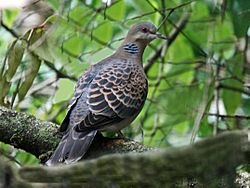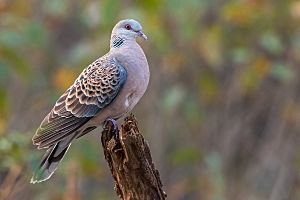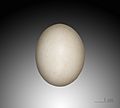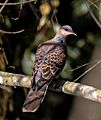Oriental turtle dove facts for kids
Quick facts for kids Oriental Turtle Dove |
|
|---|---|
 |
|
| Conservation status | |
| Scientific classification | |
| Kingdom: | |
| Class: | |
| Order: | |
| Family: | |
| Genus: | |
| Binomial name | |
| Streptopelia orientalis (Latham, 1790)
|
|
The Oriental turtle dove, also called the rufous turtle dove, is a type of bird. Its scientific name is Streptopelia orientalis. It belongs to the Columbidae family, which includes all doves and pigeons.
Contents
What the Oriental Turtle Dove Looks Like
This small bird looks a lot like the European turtle dove. However, the Oriental turtle dove is a bit bigger. It is about the same size as a collared dove.
It has a special black and white striped patch on the side of its neck. These stripes are made of feathers with silver tips. The chest of the Oriental turtle dove is not as pink as its European cousin. Its wing feathers are brownish, not orange-brown. They also have darker centers, which makes them look a bit scaly. Its tail is shaped like a wedge. When it flies, it moves more calmly and directly than the European turtle dove.
The sounds these doves make are different too. They do not purr like the European turtle dove. Instead, their call sounds like her-her-oo-oo. Doves from different areas might have slightly different calls.
Where Oriental Turtle Doves Live
The Oriental turtle dove lives in many places. The group called meena breeds in the western parts of Europe and Asia. Most of these birds migrate south for winter. They fly to places like India, the Maldives, and southern Japan. Some populations in the south stay in the same place all year.
Sometimes, S. o. orientalis doves are seen in places like western Alaska and British Columbia. They can also wander to northern and western Europe. When they appear in Britain, many birdwatchers get very excited!
These doves live in different kinds of places. They like to breed in areas with many trees but also open spaces. In winter, they prefer more open areas, but still with good tree cover.
Life and Habits
Reproduction and Life Cycle
The breeding season for these doves can last a long time in cooler areas. In southern India, they breed during the winter. When a male dove wants to attract a mate, he flaps his wings loudly. He then flies straight up before gliding down with his tail spread out.
Building a nest takes about two days. The male collects materials, and the female puts them together. Their nests are stronger than those of some other doves. They usually build their nests in the middle part of a tree's branches. In Japan, nests built higher up were more likely to be attacked by predators.
The male dove usually sits on the eggs during the day. The female takes over at night. Like all pigeons and doves, they lay two white eggs in their twig nest. The parents start incubating the eggs right after the first one is laid. The eggs hatch in about 15 to 16 days. The baby birds, called chicks, are ready to fly in about 15 to 17 days. Both parents feed the chicks with a special "crop milk."
These doves can raise several groups of chicks in one season. They might even reuse their old nests or nests built by other doves. Reusing nests might make it easier for predators to find them. In Japan, crows and magpies often eat the eggs and chicks. Cats and snakes also sometimes hunt them.
What Oriental Turtle Doves Eat
Oriental turtle doves eat many kinds of seeds. They like seeds from plants like hemp, sunflower, wheat, millets, and amaranth. They also eat small snails called gastropods. They usually find their food on the ground.
Health of Oriental Turtle Doves
Sometimes, nests can get dirty with bird droppings. Scientists have found different types of flies living in these dirty nests in Japan.
Tiny mites, which are like very small bugs, have been found under the skin of these doves in Japan. Also, some doves in South Korea have gotten sick and died from a virus called avian pox.
Images for kids
-
At Jayanti in Buxa Tiger Reserve in Jalpaiguri district of West Bengal, India
-
In Hsinchu City, Taiwan
-
In Hsinchu City, Taiwan
See also
 In Spanish: Tórtola oriental para niños
In Spanish: Tórtola oriental para niños












